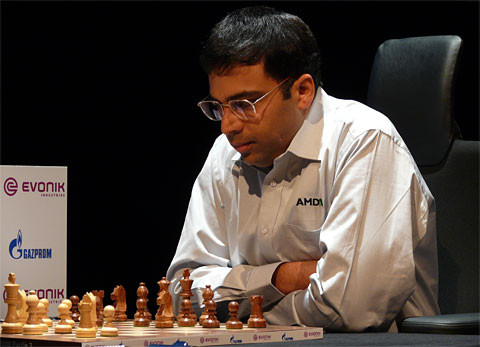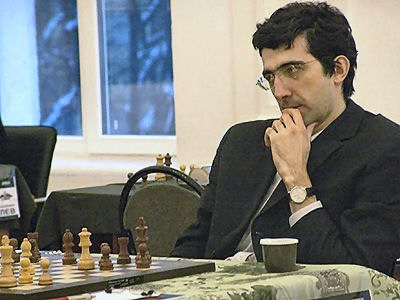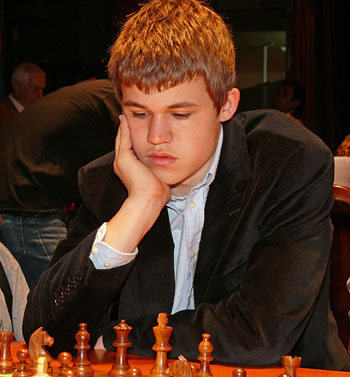| Latest | Greatest | Lobby | Journals | Search | Options | Help | Login |
|
|
|
This topic is archived. |
| Home » Discuss » Topic Forums » Sports |
|
| Jack Rabbit
|
Sat Mar-28-09 05:44 PM Original message |
| The JR Chess Report (March 28): Aronian Defends Amber Title in Nice |
|
Aronian Defends Melody Amber Championship
 Armenian grandmaster Levon Aronian defended his championship of the Melody Amber Rapid/Blindfold Tournament which was completed Thursday in the French Mediterranean city of Nice. Aronian tied for first place in both the rapid and blindfold competitions, scoring 14 points overall out of a possible 22. Reigning world champion Vishy Anand of India and former world champion Vladimir Kramnik of Russia tied for second with 13� points each. Norwegian GM Magnus Carlsen, who at 18 is often touted as a future world champion, finished fourth with 13 points after leading the blindfold competition for much of the way. Aronian tied for forst with 7 points in the blindfold competition with Kramnik and Carlsen with 7 points each while he tied for first in the rapid competition on 7 points with Anand and US grandmaster Gata Kamsky, who scored only 3 points blindfold. Last year, Aronian won the overall competition with 14� points, 2� points ahead of the field. He won the rapid competion with 8 points, two points ahead of his nearest competitor, and was part of a four-way tie for first place in the blindfold competition. Reykjavik Open in Progress  Ukranian grandmaster Yuriy Kryvoruchko and untitled Frenchman Fabien Gulleux share the lead after five rounds with 4� each in the annual 9-round Reykjavik Open in Iceland. Nine players are tied for second at 4 point apiece, including reigning US champion Yury Shulman. Calendar Reykjavik Open 23 March.-2 April. Dubai Open 3-13 April. Gausdal Chess Classic (Norway) 7-15 April. Foxwoods Open, Mashantucket, Connecticut 8-12 April. FIDE Grand Prix, Nalchik 14-29 April. Russian Club Cup (Team Championships), Sochi 30 April-12 May. US Chess Championship, St. Louis May. Exact dates TBA. MTel Masters, Sofia 9-19 May. Asian Championships, Subic Freeprot (The Philippines) 12-23 May. Chicago Open 22-25 May. Aerosvit International Tournament, Foros (Ukraine) 9-20 June. World Open, Philadelphia 29 June-5 July. Canadian Open, Edmonton 11-19 July. Czech Open, Pardubice 16 July-2 August. Biel Chess Festival 18-31 July. FIDE Grand Prix, Yerevan. 8-24 August. |
| Printer Friendly | Permalink | | Top |
| Jack Rabbit
|
Sat Mar-28-09 05:45 PM Response to Original message |
| 1. This Week's Games |
|
Your humble hare acknowledges the assistance of Fritz 6.0 on analysis. Diagrams on the Jack Rabbit Chess Report are made with Chess M�rida, a true type font that can be downlaoded free here. !""""""""# $tMvWlVmT% $OoOoOoOo% $ + + + +% $+ + + + % $ + + + +% $+ + + + % $pPpPpPpP% $RnBqKbNr% /(((((((() WHITE White to move (This position is a theoretical draw) |
| Printer Friendly | Permalink | | Top |
| Jack Rabbit
|
Sat Mar-28-09 05:50 PM Response to Reply #1 |
| 2. Melody Amber Blindfold/Rapid Tournament, Nice |
|
Edited on Sat Mar-28-09 05:50 PM by Jack Rabbit
|
| Printer Friendly | Permalink | | Top |
| Jack Rabbit
|
Sat Mar-28-09 05:54 PM Response to Reply #2 |
| 4. Aronian - Leko, Rapid, Round 2 |
 Levon Aronian Levon Aronian - Peter Leko Melody Amber Tournament (Rapid Competition), Round 2 Nice, 15 March 2009 East India Game: Queen's Indian Defense 1.d4 Nf6 2.c4 e6 3.Nf3 b6 4.g3 Ba6 5.Qc2 Bb7 6.Bg2 c5 7.d5 exd5 8.cxd5 Nxd5
9.0-0 Be7 10.Rd1 Nc6
11.Qa4
11...Nf6 12.Nh4!?
12...g6
13.Bh6 Bf8
14.Bxf8 Kxf8 15.Nc3 Kg7
16.Rd6 Na5 17.Qf4?!
17...Bxg2!
18.Kxg2 h6?!
19.Ne4 Nxe4 20.Qxe4 Re8?
!""""""""# $t+ Wt+ +% $O +o+oL % $ O T +oO% $M O + + % $ + +q+ N% $+ + + P % $pP +pPkP% $R + + + % /(((((((() WHITE: Levon Aronian Position after 20...Rh8e8 21.Rxg6+!!
21...fxg6 22.Qxg6+ Kf8 23.Qxh6+ Ke7
24.Nf5+ Kf7 25.Nd6+ Ke7
26.Rd1 Rf8 27.Rd5 Rf6 28.Qh7+ Kf8 29.Rg5 1-0
|
| Printer Friendly | Permalink | | Top |
| Jack Rabbit
|
Sat Mar-28-09 05:55 PM Response to Reply #2 |
| 5. Aronian - Radjabov, Blind, Round 8 |
 Levon Aronian Aronian,Levon - Teimour Radjabov Melody Amber Tournament (Blindfold Competition), Round 8 Nice, 22 March 2009 West India Game: Indian Queen's Gambit (Catalan Opening) (Gr�nfeld Defense) 1.c4 g6 2.d4 Nf6 3.Nc3 Bg7 4.g3 d5
5.cxd5 Nxd5 6.Bg2 Nxc3
7.bxc3 c5 8.Nf3 Nc6 9.0-0 cxd4
10.cxd4
10...Nxd4 11.Nxd4 Qxd4 12.Rb1 0-0 13.Be3
13...Qc4 14.Bd5!?
14...Qa6
15.Qb3
15...Qxe2 16.Bc5 Be6
17.Bxe6
17...Qxe6 18.Qxe6 fxe6 19.Rxb7 Rf5
20.Rc7 Be5 21.Rxe7 Bxg3
22.hxg3 Rxc5 23.Rb1 a5?
!""""""""# $t+ + +l+% $+ + R +o% $ + +o+o+% $O T + + % $ + + + +% $+ + + P % $p+ + P +% $+r+ + K % /(((((((() WHITE: Levon Aronian Position after 23...a7a5 24.Rbb7!
24...Rh5
25.Rxe6 Rd8
26.Ree7 Rc8 27.Ra7 Rd8 28.Kg2 Rf8
29.a4!
29...Rb8
30.g4 Rh4 31.f3 Rf8 32.Rxa5 h5
33.gxh5
33...Rxh5 34.Rxh5 gxh5 35.a5 Rf6
36.Rb7 h4 37.Rb3 1-0 !""""""""# $ + + +l+% $+ + + + % $ + + T +% $P + + + % $ + + + O% $+r+ +p+ % $ + + +k+% $+ + + + % /(((((((() WHITE: Levon Aronian Final Position after 37.Rb7b3
|
| Printer Friendly | Permalink | | Top |
| Jack Rabbit
|
Sat Mar-28-09 05:57 PM Response to Reply #2 |
| 6. Anand - Kramnik, Blind, Round 8 |
 Vishy Anand Vishy Anand - Vladimir Kramnik Melody Amber Tournament (Blindfold Competition), Round 8 Nice, 22 March 2009 Epine Dorsal: Horseman Defense (Center Opening) (Petroff Defense) 1.e4 e5 2.Nf3 Nf6 3.d4
3...Nxe4
4.Bd3 d5 5.Nxe5 Nd7
6.Nxd7 Bxd7 7.0-0 Bd6
8.c4 c6 9.cxd5 cxd5 10.Nc3
10...Nxc3 11.bxc3 0-0 12.Qh5 g6
13.Qxd5 Qc7 14.Bh6 Rfd8
15.h4
15...Be6 16.Qg5!?
16...Qxc3
17.Rfd1 Bf8 18.Bxf8 Rd5?!
!""""""""# $ + + Tl+% $Oo+ +o+o% $ + +vQo+% $+ +t+ + % $ + P + P% $+ Wb+ + % $p+ + Pp+% $R +r+ K % /(((((((() WHITE: Vishy Anand Position after 18...Rd8d5 19.Qf6!
19...Rxf8
20.Be4 Rh5 21.Rac1?!
21...Qa5
22.f3
22...Rb5
23.a4 Rb6?
!""""""""# $ + + Tl+% $Oo+ +o+o% $ T +vQo+% $W + + + % $p+ Pb+ P% $+ + +p+ % $ + + +p+% $+ Rr+ K % /(((((((() WHITE: Vishy Anand Position after 23...Rb5b6 24.d5!
24...Bf5 25.d6!!
25...Bxe4
26.fxe4 Qxa4 27.h5 Qxe4
28.Qe7 Qb4
29.h6 Rc6 30.Qf6 1-0
|
| Printer Friendly | Permalink | | Top |
| Jack Rabbit
|
Sat Mar-28-09 05:58 PM Response to Reply #2 |
| 7. Carlsen - Kramnik, Blind, Round 10 |
|
Edited on Sat Mar-28-09 05:58 PM by Jack Rabbit
 Vladimir Kramnik Magnus Carlsen - Vladimir Kramnik Melody Amber Tournament (Blindfold Competition), Round 10 Nice, 25 March 2009 East India Game: Nimzo-Indian Defense 1.d4 Nf6 2.c4 e6 3.Nc3 Bb4 4.Qc2 0-0 5.e4
5...d6 6.Bd3 Nc6
7.Nge2 Ba5
8.0-0
8...Bb6 9.d5 Nb4 10.Qd2 exd5 11.cxd5!?
11...Ng4 12.Bb1
12...Qh4 13.Qf4 f5 14.exf5??
!""""""""# $t+v+ Tl+% $OoO + Oo% $ V O + +% $+ +p+p+ % $ M + QmW% $+ N + + % $pP +nPpP% $RbB +rK % /(((((((() WHITE: Magnus Carlsen Position after 14.ef5:p 14...Bxf5!
15.h3 Bxf2+
16.Kh1 Bd7 17.Qg5
17...Bc5 18.Rxf8+ Rxf8 19.Ng1
19...Rf1 20.Bxh7+ Kh8 0-1
|
| Printer Friendly | Permalink | | Top |
| Jack Rabbit
|
Sat Mar-28-09 06:00 PM Response to Reply #2 |
| 8. Anand - Carlsen, Blind, Round 3 |
 Magnus Carlsen Vishy Anand - Magnus Carlsen Melody Amber Tournament (Blindfold Competition), Round 3 Nice, 16 March 2009 Spanish Sicilian Game: Canal Defense 1.e4 c5 2.Nf3 Nc6 3.Bb5 d6
4.0-0
4...Bd7 5.Re1 Nf6 6.c3 a6 7.Bf1
7...Bg4 8.d3
8...e6 9.Nbd2 Be7
10.h3 Bh5 11.g4 Bg6 12.Nh4 Nd7 13.Ng2
13...h5
14.f4 hxg4 15.hxg4 Qc7!?
16.Nf3
16...0-0-0
17.Ne3 Nb6 18.Nc4?!
18...Nxc4 19.dxc4 !""""""""# $ +lT + T% $+oW VoO % $o+mOo+v+% $+ O + + % $ +p+pPp+% $+ P +n+ % $pP + + +% $R BqRbK % /(((((((() WHITE: Vishy Anand Position after 19.dc4:N 19...f5!
20.exf5 exf5 21.g5
21...Bf7 22.Qc2?!
22...g6 23.Qf2 d5 24.cxd5
24...Bxd5 25.Be3
!""""""""# $ +lT + T% $+oW V + % $o+m+ +o+% $+ Ov+oP % $ + + P +% $+ P Bn+ % $pP + Q +% $R + RbK % /(((((((() WHITE: Vishy Anand Position after 25.Bc1e3 25...Bxg5!!
26.Qg3
26...Be7 27.Bg2 g5 28.Nxg5
28...Bxg5 29.Bxd5 Rxd5 30.Qxg5 Qf7 31.Kf2
31...Rh2+ 32.Kf1 Rd8 33.Qg3
!""""""""# $ +lT + +% $+o+ +w+ % $o+m+ + +% $+ O +o+ % $ + + P +% $+ P B Q % $pP + + T% $R + Rk+ % /(((((((() WHITE: Vishy Anand Position after 33.Qg5g3 33...Qc4+!
34.Kg1 Rxb2 0-1
|
| Printer Friendly | Permalink | | Top |
| Jack Rabbit
|
Sat Mar-28-09 05:53 PM Response to Reply #1 |
| 3. Reykjavik Open |
| Printer Friendly | Permalink | | Top |
| Jack Rabbit
|
Sat Mar-28-09 06:02 PM Response to Reply #3 |
| 9. Meszaros - Kryvoruchko, Round 4 |
 Yuriy Kryvoruchko To view this game:
Michal Meszaros - Yuriy Kryvoruchko Open Tournament, Round 4 Reykjavik, 27 March 2009 Open Sicilian Game: Kan Defense (Polugaevsky Opening) 1.e4 c5 2.Nf3 e6 3.d4 cxd4 4.Nxd4 a6 5.Bd3
5...Bc5 6.Nb3 Be7
7.Qg4
7...Bf6
8.0-0 Nc6 9.f4 d6 10.Qg3
10...Nge7!?
11.N1d2
11...0-0
12.Nc4
12...Ng6 13.Be3 b5 14.Nb6!
14...Rb8 15.Nxc8
15...Qxc8 16.c3 b4 17.Rac1
17...bxc3 18.bxc3 a5 19.Nd4 e5
20.f5 Nf4 21.Nxc6
21...Qxc6 22.Bxf4
22...exf4 23.Qxf4 Rb2
24.Rc2 Rfb8 25.Rxb2?!
25...Rxb2 26.a4 h6!?
27.Bb5
!""""""""# $ + + +l+% $+ + +oO % $ +wO V O% $Ob+ +p+ % $p+ +pQ +% $+ P + + % $ T + +pP% $+ + +rK % /(((((((() WHITE: Michal Meszaros Position after 27.Be3b5 27...Qc5+!
28.Kh1 Bxc3?!
29.f6?!
29...Bxf6 30.Qg4 Qc2 31.h3 Rb1 32.Qd7?
!""""""""# $ + + +l+% $+ +q+oO % $ + O V O% $Ob+ + + % $p+ +p+ +% $+ + + +p% $ +w+ +p+% $+t+ +r+k% /(((((((() WHITE: Michal Meszaros Position after 32.Qg4d7 32...Qxe4!
33.Qxd6
33...Rxf1+ 34.Bxf1 Qxa4 35.Qb8+
35...Kh7 36.Qb1+
36...g6 37.Qb7 Kg7 38.g4 Qf4 39.Qg2 a4 40.Bb5 a3 0-1
|
| Printer Friendly | Permalink | | Top |
| Jack Rabbit
|
Mon Mar-30-09 02:16 AM Response to Reply #3 |
| 10. Maze -Guilleux, Round 5 |
|
Fabien Guilleux is an 18-year-old federation master (FM) from France who played on the top board in Reykjavik in Round 6 after taking 4� points in the first five rounds.
This is M. Guilleux' fifth round victory over his compatriot, Sebastien Maze.  Fabien Guilleux Sebastien Maze - Fabien Guilleux Open Tournament, Round 5 Reykjavik, 28 March 2009 Open Sicilian Game: Najdorf-Scheveningen Defense (Rauzer Opening) 1.e4 c5 2.Nf3 d6 3.d4 Nf6 4.Nc3 cxd4 5.Nxd4 Nc6 6.Bg5 e6 7.Qd2 a6
8.0-0-0 Bd7
9.f3
9...Be7 10.h4
10...Rc8
11.Nxc6
11...Bxc6 12.Kb1!?
12...Qc7
13.Bf4 Rd8 14.g4
14...b5 15.a3 Qb7 16.Bd3 d5 17.g5?
!""""""""# $ + Tl+ T% $+w+ VoOo% $o+v+oM +% $+o+o+ P % $ + +pB P% $P Nb+p+ % $ PpQ + +% $+k+r+ +r% /(((((((() WHITE: Sebastien Maze Position after 17.g4g5 17...Nxe4!!
18.fxe4 dxe4 19.Nxe4 Bxe4 20.Rh3
20...0-0!?
21.h5
21...b4
22.Be5?!
!""""""""# $ + T Tl+% $+w+ VoOo% $o+ +O+ +% $+ + B Pp% $ O +v+ +% $P +b+ +r% $ PpQ + +% $+k+r+ + % /(((((((() WHITE: Sebastien Maze Position after 22.Bf4e5 22...bxa3!
23.b3 Bxd3 24.Rxd3 Rxd3 25.Qxd3 Bxg5
26.Qc3 f6!?
27.Bg3?!
27...Rc8 28.Qa5 f5 29.Be5
29...Qe4 30.Rd3 Qh1+ 0-1
|
| Printer Friendly | Permalink | | Top |
| Jack Rabbit
|
Tue Mar-31-09 01:15 PM Response to Original message |
| 11. Update (Tuesday): FIDE releases Spring Ratings List: Topa on Top |
|
Bulgarian grandmaster and former FIDE world champion Veselin Topalov is the number one ranked player in the world with an Elo score of 2812, the highest rating since the retirement of Garry Kasparov, according to the Spring ratings list released by FIDE today.
Reigning world champion Vishy Anand is second with a rating of 2783 and 18-year-old Norwegian GM Magnus Carlsen is third at 2770. Among women players, Hungarian GM Judit Polgar, who is often regarded as being in a class by herself, is first at 2693. Indian GM Koneru Humpy, the only other woman in history to break the 2600 mark, is second at 2612 while 15-year-old Hou Yifan of China is knocking at the door of the 2600 barrier at 2590 in third place. Russian IM Tatiana Kosintseva, after a very successful winter, is in tenth place at 2522, up 25 points from January. The list of top players can be found at Susan Polgar's blog. |
| Printer Friendly | Permalink | | Top |
| DU
AdBot (1000+ posts) |
Sun May 05th 2024, 03:31 AM Response to Original message |
| Advertisements [?] |
| Top |
| Home » Discuss » Topic Forums » Sports |
|
Powered by DCForum+ Version 1.1 Copyright 1997-2002 DCScripts.com
Software has been extensively modified by the DU administrators
Important Notices: By participating on this discussion board, visitors agree to abide by the rules outlined on our Rules page. Messages posted on the Democratic Underground Discussion Forums are the opinions of the individuals who post them, and do not necessarily represent the opinions of Democratic Underground, LLC.
Home | Discussion Forums | Journals | Store | Donate
About DU | Contact Us | Privacy Policy
Got a message for Democratic Underground? Click here to send us a message.
© 2001 - 2011 Democratic Underground, LLC